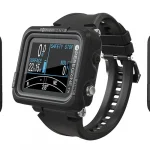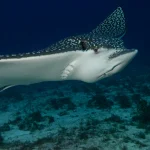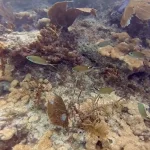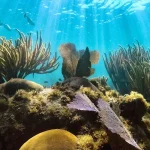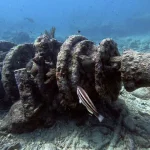Table of Contents
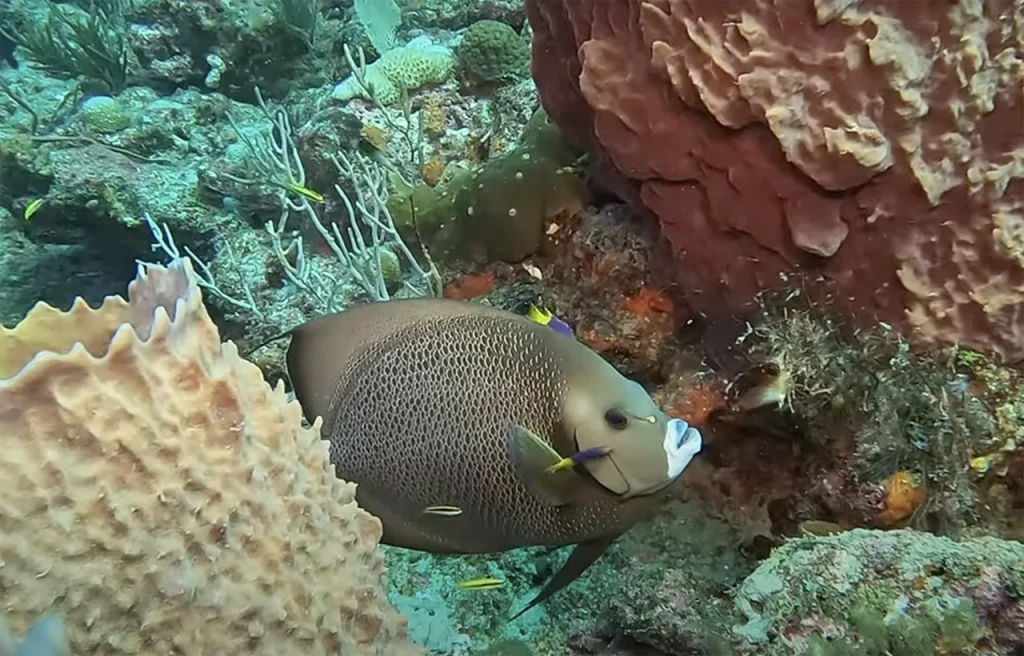
The Flower Gardens is a renowned dive site located approximately 4.25 nautical miles south of the Palm Beach Inlet, off the coast of West Palm Beach, Florida.
Article at a Glance
- Location: Located 4.25 nautical miles south of the Palm Beach Inlet, this offshore reef is accessible only by boat and is a popular dive destination.
- Depth Range: Dives typically range from 42 to 54 feet (13 to 16 meters), with occasional depths reaching up to 68.9 feet (21 meters).
- Marine Life: Expect encounters with sea turtles, nurse sharks, reef sharks, stingrays, moray eels, and vibrant schools of tropical fish like angelfish and parrotfish.
- Coral Features: The site boasts lush coral gardens with a mix of hard and soft corals, including brain and star corals, creating a stunning underwater landscape.
- Best Time to Dive: The ideal season is May to October, offering calm seas, warm water (78–84°F), and excellent visibility (up to 100+ feet).
- Diver Skill Level: Suitable for intermediate and advanced divers due to potential currents; beginners can enjoy the site with guided tours and proper preparation.
- Special Highlights: Perfect for underwater photography with its vibrant marine life and coral structures; night dives reveal unique nocturnal species and glowing corals.
Flower Gardens West Palm Beach
- Depth: The average depth of the Flower Gardens is around 21 meters (approximately 68.9 feet), making it accessible for various skill levels, including both novice and experienced divers.
- Visibility: Divers can expect good visibility, typically ranging from 10 to 30 meters (about 33 to 98 feet), which enhances the diving experience by allowing for clear views of the underwater scenery.
- Marine Life: The site is home to diverse marine species, including schools of tropical fish, sea turtles, and occasionally larger species like stingrays and moray eels. The presence of vibrant coral formations adds to the visual appeal.
Diving Experience
Diving at Flower Gardens often includes:
- Current Conditions: The site generally experiences light currents, making it suitable for drift diving. Divers have reported enjoyable conditions with temperatures around 22-23°C (72-73°F) during dives.
- Flora and Fauna: The gardens are characterized by lush soft corals and an abundance of fish life. Notable encounters include green sea turtles and various species of angelfish, which are frequently spotted during dives.
Accessibility and Services
Several dive operators offer trips to the Flower Gardens, providing services such as:
- Equipment Rentals: Most dive shops in the area, like Pura Vida Divers and Calypso Dive Charters, offer rental equipment and guided tours to ensure a safe and enjoyable experience.
- Booking Requirements: It’s advisable to book in advance due to the popularity of this dive site. Many charters require appointments for diving excursions.
What Marine Life Can I Expect To See?
- Sharks: Nurse sharks and reef sharks are common sightings, with occasional appearances by great hammerhead sharks.
- Rays: Eagle rays and stingrays are often spotted gliding through the waters.
- Sea Turtles: Green sea turtles and hawksbill turtles are frequent visitors, sometimes seen resting or feeding on the reef (2)(3).
- Tropical Fish: Dense schools of tropical fish, including angelfish, parrotfish, grunts, snappers, and butterflyfish, are abundant.
- Lobsters: Both spiny and slipper lobsters can be found hiding in reef crevices.
- Eels: Green moray eels are a notable resident species, often seen poking their heads out of holes.
- Other Species: Scorpionfish, goliath groupers, barracudas, and even occasional batfish add to the site’s biodiversity.
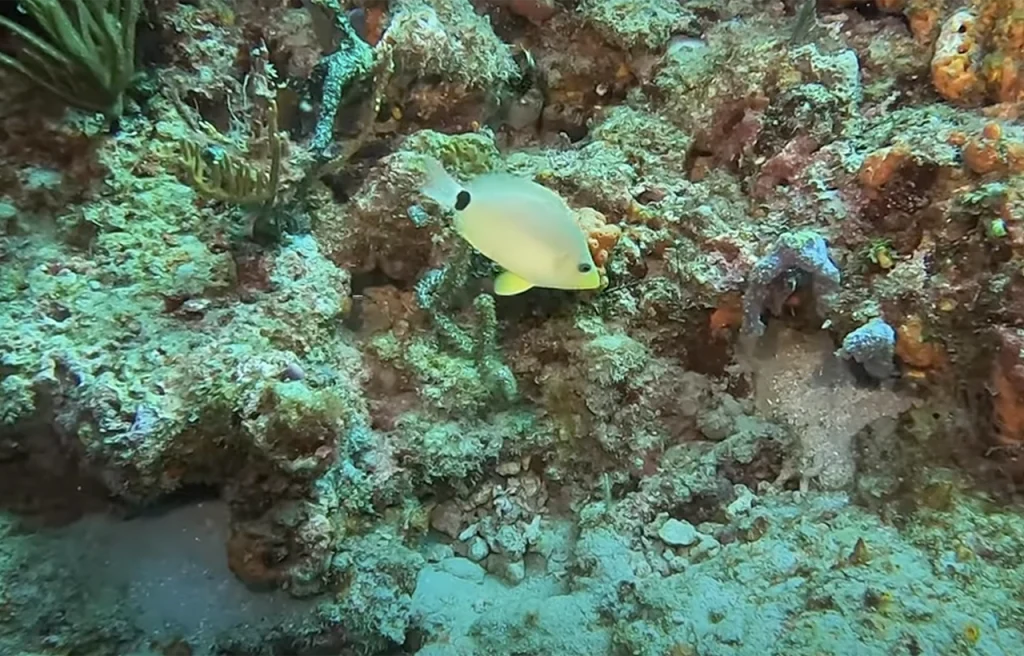
What Do Divers Say About This Site?
- Vibrant Ecosystem: Many divers describe the Flower Gardens as a “breathtaking reef site,” highlighting the vibrant coral formations and abundant marine life. The site is noted for its “immense fields of soft and hard corals” that create an enchanting underwater experience.
- Visibility and Conditions: Divers often report excellent visibility, commonly around 50 feet or more, which enhances the diving experience. The water temperature is typically comfortable, around 72-73°F, making it pleasant for extended dives.
- Diverse Marine Life: The diversity of marine species is a significant highlight. Divers frequently encounter large schools of tropical fish, sea turtles, and even sharks. Reports mention sightings of nurse sharks, green moray eels, and various species of rays, contributing to a rich diving experience.
- Accessibility for All Levels: The site is suitable for divers of all experience levels, from beginners to advanced. Many operators emphasize that it’s an ideal location for underwater photographers due to the colorful coral gardens and active marine life.
- Overall Experience: Divers appreciate the organized trips provided by local dive operators, which include guided tours and equipment rentals. Reviews often commend the professionalism and expertise of dive guides who enhance the overall experience by showing divers the best spots on the reef.
Key Information
| Category | Details |
|---|---|
| Location | 4.25 nautical miles south of the Palm Beach Inlet, offshore Palm Beach, FL. |
| Depth Range | 42–54 feet (13–16 meters), with occasional depths up to 68.9 feet (21 m). |
| Visibility | 50–100+ feet (15–30 meters) in summer; 30–75 feet (10–23 meters) in winter. |
| Water Temperature | 72–78°F (22–26°C) in winter; 78–84°F (26–29°C) in summer. |
| Marine Life Highlights | Sea turtles, nurse sharks, reef sharks, rays, moray eels, tropical fish. |
| Coral Features | Vibrant hard and soft corals, including brain and star corals. |
| Best Time to Dive | May to October (calm seas, warm water, peak visibility). |
| Diver Skill Level | Suitable for intermediate to advanced divers; beginners with guides. |
| Current Conditions | Light to moderate currents; drift diving is common. |
| Accessibility | Boat access only; trips offered by local dive operators. |
| Special Highlights | Ideal for underwater photography; night dives reveal nocturnal marine life. |
| Conservation Status | Protected reef system with regulations to preserve marine life and habitat. |
Highlights of Diving This Site?
Unique Underwater Features
- Shallow Ledge: The site features a shallow ledge that provides both inside and outside drops, creating varied diving experiences for all skill levels.
- Coral Forests: Divers can explore expansive fields of soft and hard corals, which sway gently in the current, making for an enchanting underwater landscape.
Marine Life Diversity
- Rich Biodiversity: Expect to see a variety of marine species, including nurse sharks, reef sharks, eagle rays, sea turtles, stingrays, and numerous tropical fish such as snapper, angelfish, and parrotfish.
- Signature Species: Notable finds include spiny lobsters and green moray eels, which are often spotted hiding among the coral.
Diving Conditions
- Visibility: The site typically boasts excellent visibility, ranging from 10 to 30 meters (about 33 to 98 feet), allowing divers to fully appreciate the vibrant ecosystem.
- Depth Range: The average depth is around 21 meters (approximately 68.9 feet), making it accessible for both novice and experienced divers.
Ideal for Photographers
- Underwater Photography: The colorful corals and diverse marine life make Flower Gardens a prime location for underwater photographers looking to capture stunning images of aquatic life in a vibrant setting.
Accessibility
- Boat Access: The site is accessible only by boat, which adds an element of adventure to the diving experience. Several dive operators offer guided trips to ensure a safe and enjoyable outing.
My Favorite Dive Computers
I have compared the 3 top diving computers for each category to help making the right choice easier:
Iconic Spots At This Site
East and West Flower Garden Banks
- Coral Caps: These areas boast coral caps covering 250 and 100 acres, respectively, with live coral coverage of up to 50%. Massive formations of brain corals, star corals, and sponges create a vibrant underwater landscape.
- Marine Life: Schools of chromis, creolefish, parrotfish, and butterflyfish are abundant. Larger species like barracudas, sea turtles, and rays are also frequently spotted.
- Sand Channels: Between coral mounds, divers can find sand patches where bottom dwellers like peacock flounders and yellowhead jawfish reside.
Stetson Bank
- Unique Topography: Known for its siltstone pinnacles encrusted with fire coral and sponges, this 36-acre reef is a favorite for spotting large pelagics like manta rays, silky sharks, and whale sharks during migration seasons.
- Rare Species: The golden smooth trunkfish, found in only two places globally, is a highlight here.
Sierra Madracis
- Largest Coral Formation: Located at Stetson Bank, this pinnacle is famous for its stunning coral structures and vibrant marine ecosystems.
The Kraken Wreck
- Artificial Reef: Outside the sanctuary, this intentionally scuttled cargo vessel offers exciting swim-throughs and attracts diverse marine life.
Platform Dives
- Manmade Habitats: Oil platforms nearby are covered in sponges, hydroids, and colonial anemones. Loggerhead turtles and silky sharks are often seen cruising around these structures.
Environmental Conservation Efforts at Flower Gardens
Monitoring and Research
- Long-term monitoring programs are in place to assess the health of coral reefs and marine species. Research initiatives help track changes in biodiversity and coral health, enabling timely interventions when necessary (1).
Restoration Projects
- Efforts include restoring damaged coral reefs through transplantation and propagation techniques. These projects aim to enhance the resilience of coral populations against climate change and disease (7).
Community Engagement and Education
- Local organizations, such as the Garden Club of Palm Beach, engage in conservation education, advocating for the restoration of local ecosystems like the Everglades. They support initiatives that promote awareness about marine conservation among residents and visitors (6).
Collaboration with Agencies
- The sanctuary collaborates with various environmental agencies, including the South Florida Water Management District, to implement comprehensive conservation strategies that encompass both land and marine environments.
Invasive Species Management
- Active management of invasive species is crucial for protecting native flora and fauna. Programs focus on removing invasive plants and animals that threaten local ecosystems.
Legislative Support
- Advocacy for legislative measures that protect marine resources is ongoing, with organizations pushing for policies that enhance conservation efforts at both state and national levels.
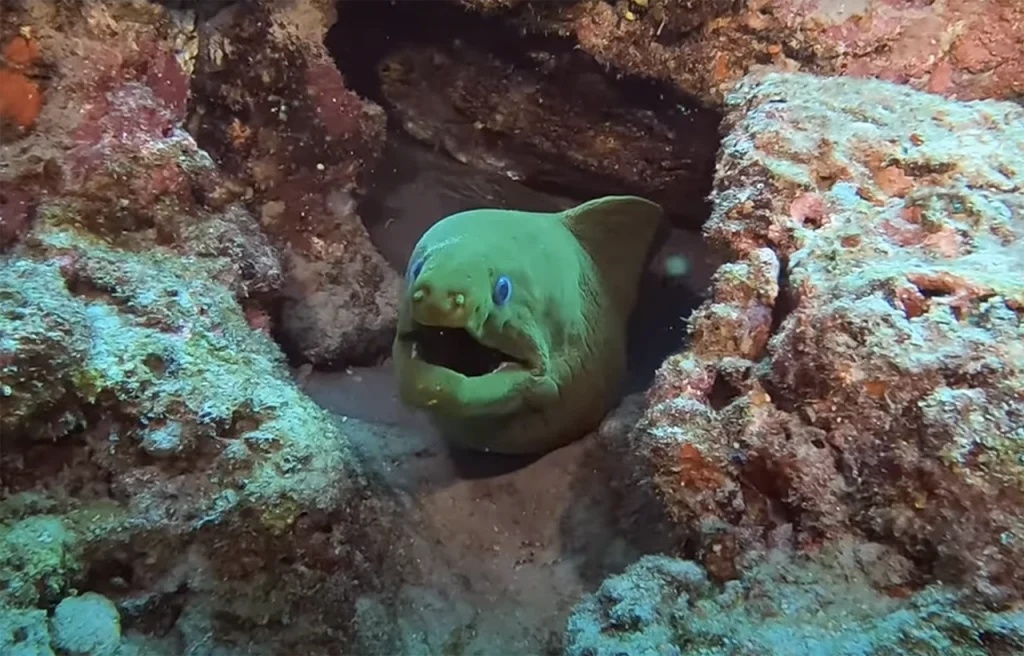
Maximizing Your Diving Experience at Flower Gardens
Dive Planning and Preparation
- Skill Level: This site is best suited for intermediate to advanced divers due to variable currents and depths (typically 70–130 feet). Prior experience with currents and using a surface marker buoy is highly recommended.
- Nitrox Certification: Using Nitrox is advised to offset nitrogen loading during deeper dives and extend bottom time safely.
- Gear Essentials: Bring gloves (for handling mooring lines), a safety sausage, and a LifeLine device for open-ocean dives. These are critical for safety in case of separation from the group or liveaboard.
Dive Profiles and Conditions
- Depths: Most dives range between 60–90 feet, with a maximum depth of 130 feet on the first dive of the day. Subsequent dives are limited to 100 feet.
- Visibility: Visibility is excellent, ranging from 75–150 feet in summer, though it can drop to 30–75 feet in winter.
- Currents: Be prepared for changing currents that can vary in speed and direction at different depths. Surface currents may require hand-over-hand descents along mooring lines.
Dive Highlights
- Marine Life: Expect encounters with manta rays, whale sharks (in summer), sea turtles, moray eels, barracudas, and large schools of tropical fish like snapper and angelfish. Night dives reveal feeding corals and nocturnal species.
- Coral Reefs: The site features vibrant coral heads, including brain and star corals, some as large as cars. These reefs are among the healthiest in the world.
Recommended Itinerary
- Liveaboard Diving: Liveaboards like the MV Fling offer two- or three-day trips with multiple dives per day, including night dives. This is the most practical way to explore the Flower Gardens due to its offshore location.
- Dive Sites:
- East and West Flower Garden Banks: Known for colossal coral formations and diverse marine life.
- Stetson Bank: Famous for its unique siltstone pinnacles and sightings of sharks, rays, and other large pelagics.
Seasonal Considerations
- Best Time to Dive: Summer (May–October) offers calm seas, warm water (mid-70s°F to mid-80s°F), and peak visibility. Winter diving (February–April) features cooler waters (high 60s°F) but offers unique encounters like hammerhead sharks.
Capturing Memories at Flower Gardens: Photography Tips
Equipment Essentials
- Underwater Camera: Use a camera with a wide-angle lens for reefscapes and a macro lens for close-ups of coral and small marine life.
- Lighting: Bring external strobes or blue-filtered lights to enhance colors underwater, especially when capturing fluorescent corals.
- Protective Housing: Ensure your camera is in a waterproof housing rated for the depth you’ll be diving.
Mastering Composition
- Get Close: Water reduces sharpness and color saturation, so get as close as possible to your subject to minimize distortion.
- Foreground Interest: Include elements like coral formations or marine life in the foreground to add depth to reefscape shots.
- Rule of Thirds: Position subjects off-center for a more dynamic composition, and use natural lines like coral ridges to guide the viewer’s eye.
Lighting Techniques
- Ambient Light: Shoot in shallow water where natural light is stronger, ideally with the sun behind you for vibrant blue backgrounds (4).
- Strobe Placement: Position strobes at a 45-degree angle to avoid backscatter (light reflecting off particles in the water) (5).
- Fluorescent Photography: Use blue lights or filters at night dives to capture the glowing colors of corals and marine life.
Timing Your Shots
- Morning Dives: Early dives often provide calmer waters, better visibility, and softer natural light.
- Night Photography: For unique shots, dive at night to capture nocturnal marine life and fluorescent coral. Use slow shutter speeds but ensure proper buoyancy control to avoid blurry images.
Ethical Practices
- Avoid touching or disturbing marine life and coral reefs. Practice good buoyancy control to prevent accidental damage to the ecosystem.
Experimentation
- Try different angles, such as shooting upwards towards the surface to capture silhouettes or reflections of light on the water.
- Use macro settings for intricate details like coral textures or tiny marine creatures like nudibranchs.
Frequently Asked Questions
When is the best time to dive Flower Gardens?
The best time to dive the Flower Gardens in Palm Beach is generally during the summer months (May to October).
Calm Seas and Warm Water: Summer offers flat seas and warm water temperatures, often reaching around 80°F, making it ideal for comfortable diving conditions.
Peak Visibility: Visibility is typically excellent during this period, ranging from 50 to 150 feet, which enhances the experience of exploring the vibrant coral reefs and marine life.
Abundant Marine Life: Summer months coincide with increased marine activity. Divers often encounter schooling fish, sea turtles, and even larger species like sharks and rays.
Winter diving (November to March) is also possible, with water temperatures around 72–78°F and visibility slightly reduced (30–75 feet). However, winter currents can be stronger, making summer the preferred season for most divers.
What is the visibility like while diving Flower Gardens?
Visibility while diving at the Flower Gardens in Palm Beach is generally excellent, particularly during the summer months.
Summer Visibility: During the summer (May to October), visibility often exceeds 100 feet (approximately 30 meters) on good days, with typical ranges between 75 to 125 feet. This clear water allows divers to fully appreciate the vibrant coral reefs and abundant marine life.
Winter Visibility: In the winter months (November to April), visibility can drop to around 30 to 75 feet (approximately 10 to 23 meters) due to cooler temperatures and potential weather changes.
General Conditions: The average visibility reported by divers ranges from 10 to 30 meters, making it suitable for divers of all levels.
How deep are the dives at Flower Gardens
The dives at the Flower Gardens in Palm Beach typically range in depth from 42 to 54 feet (13 to 16 meters), making it an ideal site for Open Water Certified divers. This relatively shallow depth allows for extended bottom time and is perfect for exploring the vibrant coral formations and diverse marine life.
Some areas of the reef may reach slightly deeper, with occasional reports of depths up to 68.9 feet (21 meters) depending on the specific dive site or conditions. Overall, the Flower Gardens’ moderate depth makes it accessible for divers of varying experience levels while offering plenty of opportunities for underwater photography and marine exploration.
Is Flower Gardens suitable for beginners?
The Flower Gardens in Palm Beach is generally considered suitable for beginners, but there are some important considerations to keep in mind:
Depth: The dives typically range from 42 to 54 feet (approximately 13 to 16 meters), which is within the limits for Open Water Certified divers. This depth allows for a comfortable diving experience without going too deep too quickly.
Marine Life and Conditions: The site features vibrant coral reefs and abundant marine life, making it an exciting location for new divers. However, beginners should be aware of potential currents, which can vary in strength and may require good buoyancy control.
Guided Dives: Many dive operators offer guided dives, which can enhance safety and provide valuable instruction for those new to diving. These guides can help beginners navigate the underwater terrain and ensure a safe experience.
Experience Level: While the site is accessible to beginners, divers should be comfortable in the water and ideally have some prior training or experience with basic diving skills. Those who are athletic and confident in the water may find it easier to adapt to the conditions.
Is Flower Gardens suitable for advanced divers?
The Flower Gardens in Palm Beach is generally considered suitable for advanced divers, primarily due to the following factors:
Depth and Conditions: While the dive depths typically range from 42 to 54 feet, conditions can vary significantly. Advanced divers are better equipped to handle the potential for strong currents and unpredictable weather, which are common in this area. Although there are occasions when conditions may be calm and suitable for beginners, these instances are rare and cannot be relied upon.
Current Challenges: Divers often experience multiple currents running in different directions and speeds at varying depths. This necessitates a level of skill in buoyancy control and navigation, making it more appropriate for those with advanced training and experience in similar environments.
Safety Considerations: Advanced divers are typically more adept at managing safety protocols, such as using surface marker buoys and performing safety stops, which are crucial given the potential hazards of diving in offshore environments like the Flower Gardens.
Palm Beach Diving Sites
- Blue Heron Bridge
- Breakers Reef
- Flower Gardens
- Juno Ledge
- King Neptune
- Northwest Double Ledges
- South Double Ledges
- Cable Crossing
- Breakers 3rd Window
- Rons Rock
- Ballentine Reef
- Worth Avenue Pier Debris
- Playpen or Playground
- Bath and Tennis
- North and South Turtle Mounds
- Shark Canyon
- Larsens Valley
- Hole in the Wall
Reference List
- (1) The Southeast Florida Marine Debris Reporting and Removal Program
- (2) Loggerhead Turtle
- (3) Information About Sea Turtles: General Behavior
- (4) How to photograph coral reefscapes
- (5) Underwater Tips for photographing coral
- (6) Active Divers Association
- (7) SHORE PROTECTION AND BEACH RENOURISHMENT PROJECT

